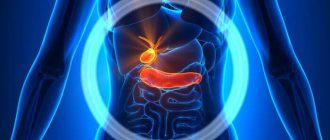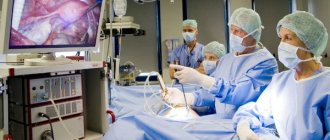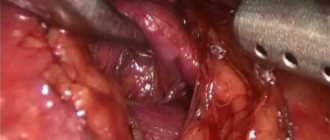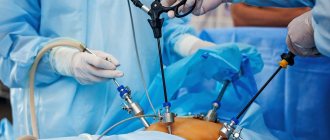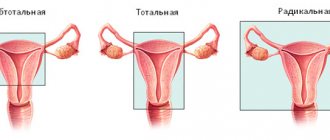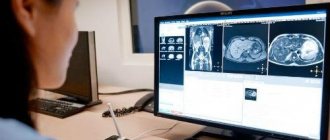Abdominal hysterectomy involves a skin incision on the anterior abdominal wall through which surgical intervention is performed. This method is used for complex pathologies or certain characteristics of the female body.
Abdominal hysterectomy is recommended for the following diseases:
- uterine fibroids - the formation of large benign tumors;
- endometriosis - tissues form inside the uterus that line it from the inside and spread to surrounding organs;
- prolapse of the uterus - when the muscles weaken, the uterus descends into the vagina, creating a lot of unpleasant sensations;
- painful sensations in the pelvic area - occur in the presence of pathologies, for example, fibroids, adhesions, infections, trauma;
- cancer of the uterus, cervix, fallopian tubes or ovaries;
- abnormal uterine bleeding - appears due to hormonal imbalance, the presence of infections, fibroids, polyps, malignant tumors, and also after menopause.
Indications for cholecystectomy
The gallbladder is a kind of “storage” of bile, which is required for trouble-free digestion. But often problems develop from the bladder itself, which is why abdominal surgery to remove the gallbladder is practiced, which is referred to as “cholecystectomy.” Indications:
- cholelithiasis;
- noncalculous cholecystitis;
- cholesterosis – “impregnations” of cholesterol in the gall bladder walls;
- polyposis;
- metaplasia;
- gallbladder disorders accompanied by pain that cannot be eliminated by conservative methods.
The most common reason for cholecystectomy is the presence of one or more stones in the gall bladder. Removing stones without removing the gallbladder is becoming less and less common.
The formation of stones in the gallbladder is an indication for cholecystectomy also because they can provoke a series of complications - the most common are:
- perforation of the gallbladder;
- biliary peritonitis - an inflammatory process in both layers of the peritoneum due to irritation by bile that gets on them;
- empyema of the gallbladder - its suppuration.
Heavy operations
These include those cases when the patient requires additional care from doctors after the procedure. Then the rehabilitation period may take much longer - up to several months.
Typically, severe ones include:
Complex bone fracture.
Trauma to the skull and brain.
Deep wounds.
Cardiac surgeries or complex surgeries on other organs.
Peritonitis (this is advanced appendicitis).
Contraindications to cholecystectomy
There are often situations when cholecystectomy cannot be performed:
- near-death state;
- decompensated nosologies - bronchial asthma, hypertension, myocarditis and others;
- malignant neoplasia;
- endocrine or metabolic disorders with severe course - in particular, diabetes mellitus;
- blood pathology.
The final decision whether to perform cholecystectomy rests with the attending physician. He is obliged to warn the patient what he can eat after removal of the gallbladder when using a specific method of operation, when to get out of bed after it, etc.
What happens on the day I leave the hospital?
On the day of your discharge, you should plan to leave the hospital around 11:00 am. Before you leave, your doctor will issue your discharge order and write your prescriptions. You can fill your prescriptions at our outpatient pharmacy or at your local pharmacy. Memorial Hospital's outpatient pharmacy is located at:
425 East 67th Street Haupt Pavilion, Room A105 New York, NY 10065 646-888-0730
You will receive written discharge instructions including information about all your medications. Before you are discharged, your nurse will explain these instructions to you and teach you how to care for yourself. Make sure you understand how much of the medicine you should take, how and when you should take it, and what the possible side effects of taking it are. Also make sure you know when to call your doctor. If you have questions or concerns, ask your nurse and write down your answers.
If you were provided with home care services, the name and telephone number of the facility will be listed on the discharge instructions provided to you. They will also indicate exactly when such services will begin. If you have questions about these services, please contact your insurance claims specialist.
If you are ready to be discharged and the person picking you up has not yet arrived at the hospital, you can wait in the Patient Transition Lounge. A member of your healthcare team will provide you with more information.
to come back to the beginning
Types of cholecystectomy. Price of laparoscopic cholecystectomy
Cholecystectomy happens:
- open;
- laparoscopic;
- performed from mini-access.
Public method
This is a classic, until recently the most commonly used, surgical intervention with an incision of a certain length in the anterior abdominal wall, through which the incapacitated gallbladder is removed.
Stages:
- an incision in the anterior wall of the abdomen along its midline or on the right under the rib;
- examination of the gallbladder and bile ducts;
- ligation of the cystic duct and bladder vessels;
- isolating the bladder from tissue and removing it;
- installation of drainages;
- suturing the surgical wound.
The advantage of the method is convenient wide access to the bladder. Its disadvantages are significant surgical trauma and the risk of formation of adhesions in the abdomen.
Laparoscopic method
During this procedure, the gallbladder is removed under video camera control using a special laparoscopic device through a small hole in the abdominal wall. The price of laparoscopic cholecystectomy depends on the clinic where it will be performed.
Stages:
- piercing the abdominal wall in several places;
- injection of a portion of carbon dioxide into the stomach to ensure vision;
- introduction of instruments and miniature video camera;
- applying a special clip to the duct and vessels of the bladder;
- their intersection;
- removal of the gallbladder, instruments, video camera;
- sewing up holes.
The advantages of the method are that it lasts no more than an hour, is insignificantly traumatic (patients rarely complain that their right side hurts after removal of the gallbladder), and significantly reduces the length of hospital stay. Its disadvantage is that in difficult cases laparoscopic cholecystectomy is not feasible.
Cholecystectomy through mini access
This is the same cholecystectomy as with the open method, but the gallbladder is removed through a small incision (3-7 cm) under the costal arch on the right.
The advantages of the method are less traumatic and shorter hospital stay than with open cholecystectomy. Disadvantage: limited view of the abdominal cavity.
Registration of pension
In accordance with amendments dated January 1, 2015, pension certificates that confirm disability are not issued. Instead, special certificates on the assignment of pension payments are now used.
The abolition of the pension certificate as a separate document has to some extent made life easier and more difficult. But at the same time, the change in the type of document did not affect the benefits and other social rights of citizens.
The procedure for obtaining help is simple. First you need to get a referral for a medical and social examination, which confirms the presence of disability and its degree.
There are three organizations where you can get a referral:
- Russian Pension Fund;
- Treatment and prevention organization at the place of registration (the clinic where you are being monitored);
- Bodies of social protection of the population.
After passing the examination and receiving the conclusion in hand, you must again contact the Russian Pension Fund. It is possible to register on the government services website and start the process of processing all documents in your personal account.
At the same time, in accordance with the new decree of the Government of Russia, the Decree “On Amendments to the Rules for Recognizing a Person as Disabled,” the speed of processing documents for recognition of disability is increasing - now you can receive the necessary documents confirming this fact within three days.
Preoperative preparation
Before abdominal surgery to remove the gallbladder, the patient is prescribed:
- general blood analysis;
- blood chemistry;
- coagulogram and prothrombin index;
- determination of blood type and Rh factor (even if they are known);
- general urine analysis;
- testing for the presence of syphilis, hepatitis B and C;
- echo examination of the gallbladder (ultrasound);
- ECG.
For concomitant nosologies, consultation with related specialists will be required.
4-5 days before the operation, the patient is allowed to eat light food, fasting is prescribed the day before, and from 18:00-19:00 in the evening - refusal to drink water. The evening before the operation, the patient is given a cleansing enema.
Before urgent cholecystectomy, preparatory measures last no longer than 2 hours.
How is the recovery period after completion of fibroid therapy using UAE?
UAE (uterine artery embolization) is a minimally invasive operation. After it, patients are allowed to leave the walls of the medical institution the very next day after the intervention.
Additionally, a number of drugs are prescribed. They allow you to relieve pain and prevent the occurrence of certain complications. Discomfort after intervention on uterine fibroids completely disappears within 2-3 days. After a few weeks, the patient visits a doctor. This helps prevent the development of possible inflammation and infections.
In the postoperative period, vaginal discharge may occur. This is due to the fact that the remnants of fibroid nodes in some cases come out through the vagina. No special treatment is prescribed during the operation.
Important! UAE is an operation that allows not only to treat fibroids, but also to reduce the risk of severe bleeding, urinary incontinence, and an increase in abdominal size. After 5 years, 90% of patients have no change in their health status. Symptoms of fibroids do not recur.
The menstrual cycle is restored after 2-6 months. Patients over 45 years of age may begin menopause. This is due to the division of blood flow through the arteries of the uterus and ovaries.
Embolization of the uterine arteries is rightfully considered one of the safest procedures in medicine. It is characterized by a lower incidence of complications than with surgery.
All complications that arise can be divided into 3 groups:
- True. They do occur during UAE surgery.
- Invented. Usually opponents of the operation talk about them.
- Previously encountered. Such complications of the operation are not currently recorded. This is due to the fact that measures have been developed to prevent them. There are no problems with the functioning of the uterus.
Important! Abdominal surgery is more dangerous. After completion of complex abdominal surgery to eliminate fibroids, complications are more common. In addition, recovery after the intervention takes a long time. In this case, fibroids may appear again.
Let's consider the main complications that usually frighten patients who decide to undergo surgery to remove fibroids using UAE.
Negative effects of X-ray radiation. Some people claim that surgery can lead to cancer and other diseases. In fact, during the operation (removal of the formation), a special type of X-ray radiation is used. It is softer. In addition, the total radiation time rarely exceeds 2-3 minutes. In fact, such an effect can be compared to one x-ray. The dose is minimal and completely safe.
Necrosis of the uterus. If emboli of small diameter and in large quantities are introduced into the uterine artery, then it is actually possible to block the small vascular network and cause necrosis of individual layers of the organ. But embolization is carried out using particles of larger diameter. This leads to disruption of the blood supply to the formation, but does not affect the uterus itself. Subsequently, it fills with blood from other arteries, later from the uterine artery due to the development of bypass vessels.
Separation of the myomatous node into the abdominal cavity. This complication is made up. We are talking about nodes growing outside the uterus on a thin base. Some doctors believe that during embolization, the leg of the node becomes necrotic and the node, having separated from the organ, enters the abdominal cavity. No such case has been described. Moreover, a study was conducted in 2006. It showed that the nodes are not separated from the uterus.
Unbearable pain. Indeed, removal of fibroids is accompanied by unpleasant sensations. They appear after the operation is completed. But it is important to understand that today there are modern means of pain relief. Moreover, severe pain lasts only 6-8 hours. Then the discomfort gradually decreases. Even at home, the patient, after removal of myomatous nodes, can take specially prescribed medications.
Consequences of gallbladder removal and lifestyle after cholecystectomy
In the first days after surgery, bed rest. Patients are interested in what they can eat in the first days after gallbladder removal. Until the gases pass, nothing is allowed. This gas-free period lasts about 2 days. After the first passing of gases, you can eat soups, liquid mashed potatoes with water, then pureed cereals, meat and vegetables.
Diet menu No. 5 in the first week after removal of the gallbladder gradually expands. Fried and seasoned foods are excluded.
To prevent postoperative complications (pneumonia, etc.), early rise of the patient from bed is practiced.
In case of pain, the supervising doctor prescribes analgesic drugs.
After the operation, the postoperative wound is dressed daily. The drainage tubes are washed and removed after the discharge stops. The sutures are removed on average after a week.
How long do you need to stay in the hospital after laparoscopic cholecystectomy? 3-4 days, and after open cholecystectomy – up to 2 weeks. In the first month after surgery, you should limit physical activity, eat small meals 5-6 times a day. You are allowed to eat white bread, boiled meat and fish, light porridge, kefir, fermented baked milk, and stewed vegetables. Further, the diet can be expanded to the usual, but fried, spicy, fatty and smoked, canned and pickled foods should be excluded from it. Can I drink after gallbladder removal? Alcohol – no, other drinks – as agreed with the doctor.
The procedure for processing documents. Certificate No. 088/у-06:
After discharge from the hospital (after amputation of the lower limb), the patient goes to the clinic (at his place of residence) with a discharge from the hospital - to a surgeon or traumatologist (depending on the cause of the amputation). A surgeon (orthopedic traumatologist) issues certificate No. 088/у-06 to pass the commission.
Registration of an individual rehabilitation program:
With certificate (direction) No. 088/у-06, he applies to the bureau of medical and social examination, where an IPR is issued to him. The IPR is drawn up at the Bureau of Medical and Social Expertise (MSE) (in ITU branches or the ITU Main Bureau).
Address of the ITU Main Bureau and its full name:
Federal State Institution “Main Bureau of Medical and Social Expertise for Moscow” of the Ministry of Labor and Social Protection of the Russian Federation 125040 Moscow, Leningradsky Prospekt, 13, building 1 Hotline telephone E-mail Opening hours of the institution: Monday — Friday from 8.30 to 17.30 https://www.gbmsem.ru
Addresses of branches and divisions of GB ITU in Moscow https://www.77.gbmse.ru/about/byuro-mse-v-gorodakh-i-rajonakh/
Attention! Make sure that the doctors at your clinic have fully prescribed the package of rehabilitation measures.
The list of measures that should be indicated in the individual rehabilitation program:
- Prosthesis
- Prosthesis repair
- Covers for the stump, cotton, covers for the stump, wool
- Covers for the stump made of silicone, covers for the stump made of polymer material
- Orthopedic shoes
- Crutches
- Cane
- Wheelchair
Possible complications
Thanks to proven techniques, cholecystectomy proceeds safely, but in some patients complications are possible for various reasons. Medical tactics depend on them (for example, nutrition a month after removal of the gallbladder in the presence of adhesive disease should still be light). The most common complications:
- injury during bile duct surgery;
- leakage of bile;
- suppuration of a postoperative wound;
- intra-abdominal bleeding;
- thromboembolic conditions;
- formation of adhesions.
Complications require immediate correction.
On our website you will find answers to all questions, for example, what drugs are used for treatment after removal of the gallbladder or how the postoperative period goes in the elderly.
Related services: Surgical operations Laparoscopy
Will my insurance cover the cost of transporting me from the hospital after I am discharged?
If you need transportation from the hospital, you will have to pay for it yourself as it is not usually covered by insurance. It is best to have relatives or friends pick you up in a car.
If you are transferred to another facility after discharge, your claims adjuster will check to see if your insurance will cover the cost of transportation. If it doesn't cover it and your family or friends can't pick you up, the claims adjuster may suggest you use a car or ambulance service. You will be required to pay for such services.
to come back to the beginning
